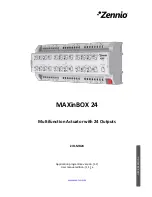
Introduction
115
SPNU563A – March 2018
Copyright © 2018, Texas Instruments Incorporated
Architecture
2.1.2 Definitions of Terms
provides a definition of terms used in the architectural block diagram.
Table 2-1. Definition of Terms
Acronym/Term
Full Form
Description
ADCx
Analog-to-Digital Converter
The ADC uses the Successive Approximation Register architecture. It features a
selectable 10-bit or 12-bit resolution. The ADC module also includes a RAM to
hold the conversion results. A digital logic wrapper manages accesses to the
control and status registers. There are two ADC modules on this device.
CCM-R5F
CPU Compare Module for
Cortex-R5F core
During lockstep mode, the outputs of the two CPUs are compared on each CPU
clock cycle by this module. Any miscompare is flagged as an error of the highest
severity level. The outputs of the two VIMs in lockstep are also compared on
each cycle by this module.
Cortex-R5F
CPU
–
The Cortex-R5F has one AXI-M master port on the CPU Interconnect
Subsystem and another AXI-PP peripheral port on the peripheral Interconnect
Subsystem for low latency access. Each master port is limited to accesses on
the resources attached to the respective interconnect.
CPU
Interconnect
Subsystem
CPU Side Switched Central
Resource Controller
This is one of the two main SCRs in the device. It arbitrates between the
accesses from multiple bus masters to the bus slaves using a round robin
priority scheme. This interconnect subsystem contains diagnostic logic to
perform parity checking on address and control signals from bus masters, parity
checking on response signals from slaves, ECC generation and evaluation on
the datapath for transactions initiated by the non-CPU masters and also self test
logic to diagnose itself.
CRCx
Cyclic Redundancy Checker
The CRC module provides two channels to perform background signature
verification on any memory region using a 64-bit maximum-length linear
feedback shift register (LFSR) . The CRC module is a bus slave in this device.
DAP
Debug Access Port
The DAP allows a tool such as a debugger to read from or write to any region in
the device memory-map. The DAP is a bus master in this device.
DCANx
Controller Area Network
controller
The DCAN supports the CAN 2.0B protocol standard and uses a serial, multi-
master communication protocol that efficiently supports distributed real-time
control with robust communication rates of up to 1 megabit per second (Mbps).
The DCAN is ideal for applications operating in noisy and harsh environments
(for example, automotive and industrial fields) that require reliable serial
communication or multiplexed wiring.
DCCx
Dual Clock Comparator
This module is primarily intended for use to determine the accuracy of a clock
signal during the execution of an application. An additional use of this module is
to measure the frequency of a selectable clock source, using the input clock as
a reference.
DMA
Direct Memory Access
The DMA module is used for transferring 8-, 16-, 32- or 64-bit data across the
entire device memory-map. The DMA module is one of the bus masters on the
device. That is, it can initiate a read or a write transaction. DMA has two master
ports with DMA_PortA and DMA_PortB. DMA_PortA is connected to the CPU
Interconnect Subsystem and DMA_PortB is connected to the Peripheral
Interconnect Subsystem. DMA can transfer data from resources in CPU
Interconnect Subsystem to resources in the Peripheral Interconnect Subsystem
and vice versa.
DMM
Data Modification Module
The DMM allows a tool to use the special DMM I/O interface to modify any data
value in any RAM on the device. The modification is done with minimal
interruption to the application execution, and can be used for calibration of
application algorithms. the DMM is also a bus master in this device.
eCAP
Enhanced Capture Module
The enhanced Capture (eCAP) module is essential in systems where accurate
timing of external events is important.
eFuse
Electronically Programmable
Fuse controller
Electrically programmable fuses (eFuses) are used to configure the device after
deassertion of PORRST. The eFuse values are read and loaded into internal
registers as part of the power-on-reset sequence. The eFuse values are
protected with Single-Bit Error Correction Double-Bit Error Detection (SECDED)
codes. These fuses are programmed during the initial factory test of the device.
The eFuse controller is designed so that the state of the eFuses cannot be
changed once the device is packaged.
















































